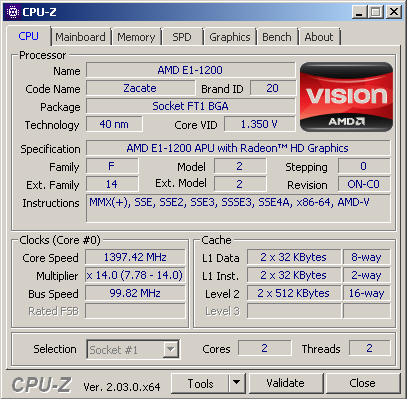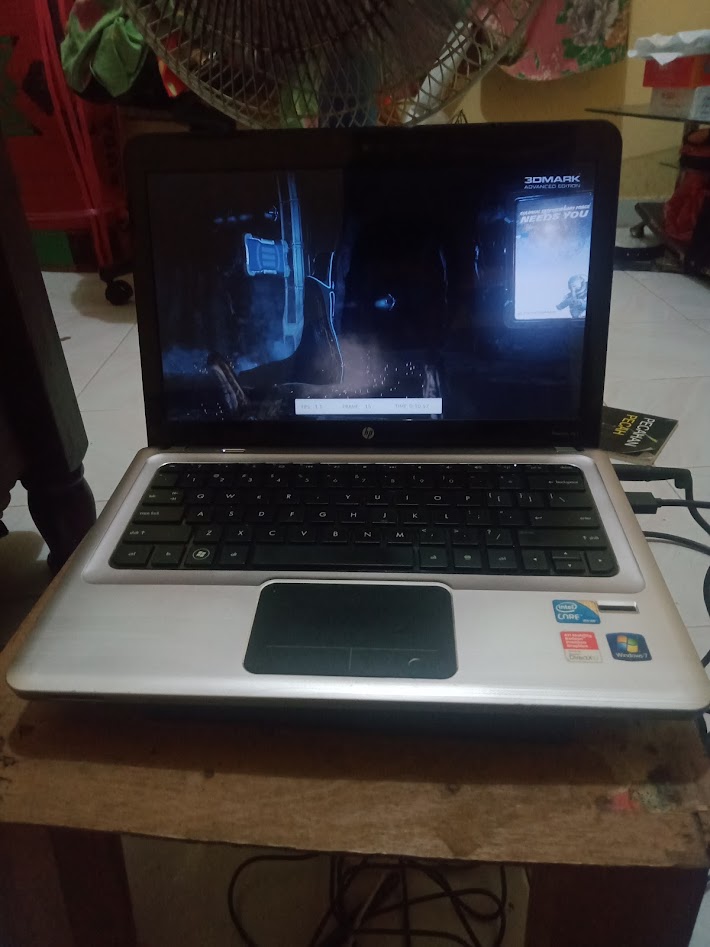Comparing: AMD E1-1200 vs Intel Core i7 720QM
In this comparison, we analyze two Processors: AMD E1-1200 and Intel Core i7 720QM, using synthetic benchmark tests to evaluate their overall performance. This side-by-side comparison helps users understand which hardware delivers better value, speed, and efficiency based on standardized testing. Whether you're building a new system or upgrading an existing one, this benchmark-driven evaluation offers valuable insights to guide your decision.
Specification Comparison Table
This specification comparison presents technical details of several devices or components to help you understand the key differences between each option. Use this table as a reference to determine which device best suits your needs.
| Specification | AMD E1-1200 | Intel Core i7 720QM |
|---|---|---|
| Architecture | x86 | x86 |
| Technology | 40 nm | 45 nm |
| Clock | 1.4 GHz - - | 1.6 GHz - 2.8 GHz |
| Core/Thread | 2 / 2 | 4 / 8 |
| Segmen | Mobile | Mobile |
Submission Comparison Table
This submission comparison table displays the number and details of benchmark data submissions from various devices or components. This information helps you understand the performance based on the benchmarks that have been tested, as well as providing an overview of the consistency and popularity of the available benchmark results.
| No. | Benchmark Software | AMD E1-1200 | Intel Core i7 720QM |
|---|---|---|---|
| 1 | 7-Zip |
2599 MIPS |
10448 MIPS |
| 2 | Cinebench - 2003 |
292 cb |
1211 cb |
| 3 | Cinebench - R11.5 |
0.54 pts |
2.71 pts |
| 4 | Cinebench - R11.5 Single Core |
0.28 pts |
0.60 pts |
| 5 | Cinebench - R15 |
44 cb |
220 cb |
| 6 | Cinebench - R15 Single Core |
23 cb |
57 cb |
| 7 | Cinebench - R20 |
79 pts |
527 pts |
| 8 | Cinebench - R20 Single Core |
43 pts |
118 pts |
| 9 | Cinebench - R23 Multi Core with BenchMate |
204 pts |
1024 pts |
| 10 | Cinebench - R23 Single Core with BenchMate |
110 pts |
301 pts |
| 11 | Geekbench3 - Multi Core |
1050 points |
4158 points |
| 12 | Geekbench3 - Single Core |
575 points |
1078 points |
| 13 | Geekbench4 - Multi Core |
1240 points |
4457 points |
| 14 | Geekbench4 - Single Core |
737 points |
1420 points |
| 15 | Geekbench5 - Multi Core |
255 points |
917 points |
| 16 | Geekbench5 - Single Core |
132 points |
282 points |
| 17 | GPUPI for CPU - 100M |
11min, 20sec, 588ms |
2min, 22sec, 383ms |
| 18 | GPUPI for CPU - 1B |
2h, 35min, 28sec, 985ms |
21min, 33sec, 52ms |
| 19 | GPUPI for CPU v.3.3 - 100M |
15min, 49sec, 435ms |
1min, 25sec, 91ms |
| 20 | HWBOT x265 - 1080P |
0.638 FPS |
4.569 FPS |
| 21 | PCMark 7 |
1092 marks |
1630 marks |
| 22 | PiFast |
1min, 49sec, 900ms |
34sec, 20ms |
| 23 | SuperPi - 1M |
55sec, 754ms |
16sec, 52ms |
| 24 | SuperPi - 32M with BenchMate |
45min, 5sec, 892ms |
22min, 4sec, 723ms |
| 25 | wPrime - 32M |
1min, 8sec, 78ms |
16sec, 279ms |
| 26 | wPrime - 1024M |
36min, 6sec, 64ms |
8min, 13sec, 257ms |
| 27 | y-cruncher - Pi-25m |
1min, 10sec, 49ms |
12sec, 665ms |
Submission Comparison Chart
This chart visualizes the benchmark scores comparison between two hardware devices based on submitted data.
Media Gallery
A collection of photos of tested hardware. These images can help you identify the physical form, model, and variant of the hardware in question. These photos are from our own documentation, and if they are not available we may not be able to document them.
About Hardware AMD E1-1200
Released in 2012 as part of the Brazos 2.0 family, the AMD E1-1200 is a power-efficient processor aimed at entry-level laptops. It has a 2 core and 2 thread configuration with a fixed clock speed of 1.4 GHz, with no support for Turbo Core technology. Built with a 40nm fabrication process, the E1-1200 has a TDP value of 18 watts-efficient enough for portable devices that emphasize low power consumption and longer battery life. Despite its limited performance, the E1-1200 was a popular choice in its day thanks to its affordable price and ability to handle light computing needs.
One of the main advantages of the AMD E1-1200 is the integrated Radeon HD 7310 GPU, which offers better graphics performance than Intel's entry-level graphics solutions at the time. This GPU has the ability to play HD resolution videos smoothly, as well as run light games such as Counter Strike 1.6, Plants vs Zombies, or other casual games with minimum graphics settings. That said, this combination of CPU and GPU is not intended for heavy-duty work such as video editing, 3D rendering, or modern gaming. Overall performance is more optimal when used for tasks such as browsing, streaming videos, accessing social media, typing documents, as well as basic office applications.
However, it should be noted that the AMD E1-1200 is less suitable for heavy multitasking, especially in modern operating systems like Windows 10. With a low clock speed and no Boost feature, users may experience lag or limitations when opening multiple applications at once. In tests using the HP 1000 1b05au laptop, this processor was paired with 4GB DDR3 single channel RAM (2 DIMM slots) and tested on Windows 7, Windows 8, and Windows 10 operating systems. The results show that the most optimal performance is achieved on Windows 7 or Windows 8, while in Windows 10 the system tends to be slow although it can still be used for basic needs. As such, the AMD E1-1200 can still be relied upon as a power-efficient and inexpensive solution for users with very light computing needs.
Hardware Detail:
Device: HP 1000 1b05au
RAM: 4GB DDR3 Single Channel 2 DIMM
OS: Windows 7, Windows 8, Windows 10
Wednesday, 26 December 2012 14:27:36 | Update: 1 month ago
About Hardware Intel Core i7 720QM
The Intel Core i7-720QM, launched in Q3 2009, was one of the first mobile quad-core processors to feature Intel's Nehalem microarchitecture, specifically the Clarksfield variant. Targeted at high-performance laptops, such as gaming machines and mobile workstations, the i7-720QM brought 4 physical cores and 8 threads to the mobile platform, thanks to Hyper-Threading Technology providing a significant boost in multi-threaded workloads like video editing, 3D rendering, and other professional-grade applications. The processor runs at a base clock speed of 1.6 GHz, but it can dynamically increase up to 2.8 GHz using Intel Turbo Boost, depending on thermal headroom and power availability.
Manufactured using a 45nm process, the i7-720QM has a TDP of 45W, which is quite high by today's mobile CPU standards. This thermal demand necessitated more robust cooling solutions in laptops that featured the chip. Unlike modern CPUs, the i7-720QM does not come with integrated graphics, which means systems based on this processor require a dedicated GPU often from AMD or NVIDIA for graphics processing and display output. As such, it was typically paired with mid-to-high-end discrete graphics cards in its time, making it a solid choice for gaming and multimedia laptops in the late 2000s and early 2010s.
While the Core i7-720QM was a powerhouse during its release, its performance and efficiency are significantly outpaced by modern CPUs built on smaller nodes and with higher IPC (Instructions Per Clock). Nevertheless, legacy laptops using the i7-720QM can still be viable for basic computing tasks like web browsing, document editing, or watching videos especially if paired with an SSD upgrade and increased RAM. Users running Windows 10 on such systems may experience some limitations, but with proper optimization and lightweight software, the CPU can still deliver a usable experience in non-demanding environments.
Hardware Detail:
Device: HP Pavilion dv3-4054TX
RAM: 4GB DDR3 Single Channel
OS: Windows 7, Windows 10
Tuesday, 19 July 2022 19:48:49 | Update: 1 month ago






